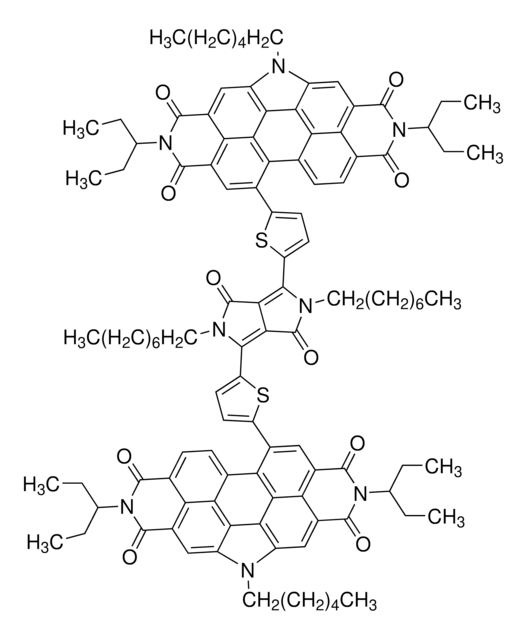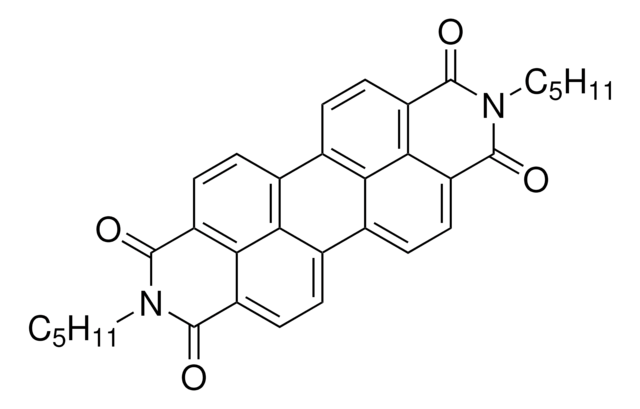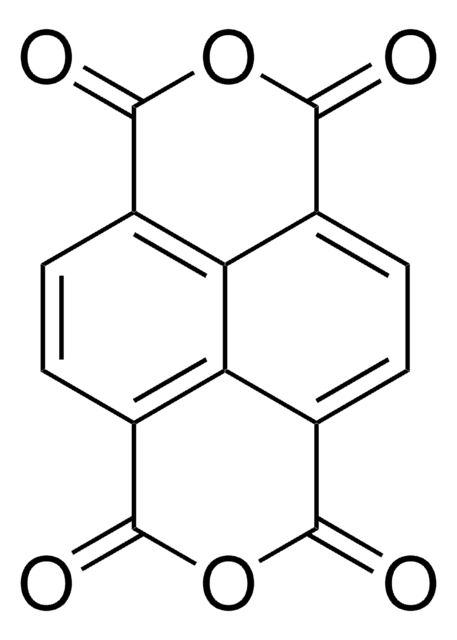932353
PTCDI
Synonym(s):
3,4,9,10-Perylenetetracarboxylic acid diimide
Sign Into View Organizational & Contract Pricing
All Photos(2)
About This Item
Empirical Formula (Hill Notation):
C24H10N2O4
CAS Number:
Molecular Weight:
390.35
MDL number:
UNSPSC Code:
12352302
NACRES:
NA.23
Recommended Products
Related Categories
Application
This TADF emitter is a sublimed high purity material, solution processable 3,4,9,10-perylenetetracarboxylic diimide has been reported for use in:
- photovoltaics
- thermoelectricity (induced by the Soret effect )
- batteries for energy storage
- photocatalysis for water purification or selective solar fuel production from CO2
- chemosensing
Signal Word
Warning
Hazard Statements
Precautionary Statements
Hazard Classifications
STOT RE 2
Storage Class Code
11 - Combustible Solids
WGK
WGK 3
Flash Point(F)
Not applicable
Flash Point(C)
Not applicable
Certificates of Analysis (COA)
Search for Certificates of Analysis (COA) by entering the products Lot/Batch Number. Lot and Batch Numbers can be found on a product’s label following the words ‘Lot’ or ‘Batch’.
Already Own This Product?
Find documentation for the products that you have recently purchased in the Document Library.
Building aqueous K-ion batteries for energy storage
L.Jiang et al.
Nature Energy, 4, 495-503 (2019)
A highly efficient covalent organic framework film photocatalyst for selective solar fuel production from CO2
R. Yadav et al.
Journal of Material Chemistry A, 4, 9413-9418 (2016)
Xianyong Wu et al.
Angewandte Chemie (International ed. in English), 56(42), 13026-13030 (2017-09-01)
Aqueous rechargeable batteries are promising solutions for large-scale energy storage. Such batteries have the merit of low cost, innate safety, and environmental friendliness. To date, most known aqueous ion batteries employ metal cation charge carriers. Here, we report the first
Di Liu et al.
Advanced materials (Deerfield Beach, Fla.), 28(33), 7284-7290 (2016-06-17)
A self-assembled perylene-3,4,9,10-tetracarboxylic diimide(PDINH) supramolecular system consisting of all-organic PDINH molecule building blocks through non-covalent interactions works as a visible light photocatalyst with high activity.
A novel water-soluble perylenetetracarboxylic diimide as a fluorescent pH probe: Chemosensing, biocompatibility and cell imaging
N. Georgiev et al.
Dyes and Pigments, 160, 28-36 (2019)
Our team of scientists has experience in all areas of research including Life Science, Material Science, Chemical Synthesis, Chromatography, Analytical and many others.
Contact Technical Service








![N,N′-Bis[2-(2-tert-butyldimethylsilyloxyethoxy)ethyl]-3,4,9,10-perylenetetracarboxylic diimide 97%](/deepweb/assets/sigmaaldrich/product/structures/334/047/4ac691aa-ae25-4df1-9e0d-09ed12cb8f1f/640/4ac691aa-ae25-4df1-9e0d-09ed12cb8f1f.png)
